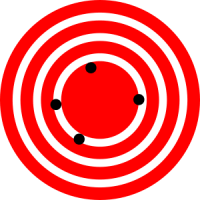Difference between revisions of "Pipette Verification"
| Line 14: | Line 14: | ||
When one is '''highly accurate''' this means that when multiple measurements are averaged, you get an answer that is very close to the true value (demonstrated by the figure on the left). | When one is '''highly accurate''' this means that when multiple measurements are averaged, you get an answer that is very close to the true value (demonstrated by the figure on the left). | ||
| − | '''The goal is to | + | '''The goal is to generate data that is both precise and accurate, but accuracy is more important than precision (this can be debated).''' |
| Line 23: | Line 23: | ||
[[File:Accuracy and precision.png|400px|thumb|center|model 2]] | [[File:Accuracy and precision.png|400px|thumb|center|model 2]] | ||
|} | |} | ||
| − | |||
==Error== | ==Error== | ||
Revision as of 11:20, 30 May 2017
Pipettes are commonly used in the biochemistry laboratory to measure/dispense small volumes of liquids. In most cases, users make the assumption that these "instruments" are fully functional, but this is not always the case. Pipettes are dropped or mistreated and this can result in the pipette requiring recalibration by a trained professional. At the beginning of any research project, it is highly recommended (ie. DO IT) that you "verify" that the pipette is working properly. An extensive discussion of this can be found here...but for research purposes, the verification procedure can be significantly less involved.
Accuracy and Precision
Before beginning the verification process, we must acknowledge the concepts of accuracy and precision. Below are two figures showing the "target grouping" model describing accuracy and precision (see Wiki for more details):
This target grouping model makes it clear that there is a "correct" or "best answer" which is often referred to as the "true" value. In the two cases above, the true value is the center of the target. When one is highly precise this means that you can reproduce a measurement multiple times and get nearly the same answer each time, but it does not necessarily mean that the measured value is close to the true valve (demonstrated by the figure on the right). When one is highly accurate this means that when multiple measurements are averaged, you get an answer that is very close to the true value (demonstrated by the figure on the left).
The goal is to generate data that is both precise and accurate, but accuracy is more important than precision (this can be debated).
The figure below is a different model for thinking about accuracy and precision.
Error
When making a measurement, there are two types of errors that lead to low accuracy and low precision, 1) systematic error and 2) random error. Systematic errors result from either the person doing the measurement or the instrument used; systematic errors can be identified and corrected. Random errors are outside the control of the researcher and are dealt with by making multiple measurements and averaging the measured values. Training aims to minimize systematic errors and hence generate highly accurate and highly precise data.
Recommended Verification Procedure using Gravimetric Test


